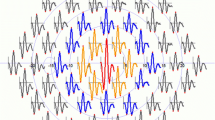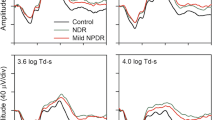Abstract
Macular and paramacular electroretinograms in response to two adjacent checks (6 deg/side), alternating at constant mean luminance, were recorded in 34 normal subjects ranging in age from 16 to 74 years. The macular electroretinogram declines progressively in amplitude with age (R = −0.42; P = 0.013). The amplitude ratio between macular and paramacular responses tends to be independent of age (R = -0.21; P = 0.22).
Age-related changes in the macular electroretinogram shown in our study are consistent with previous anatomical and functional studies, which indicate a deterioration of photoreceptors beyond 20 years of age. These results suggest a possible use of this technique for future studies on macular degeneration.
Similar content being viewed by others
References
Bagolini B, Porciatti V, Falsini B, Neroni M, Moretti G. Simultaneous macular and paramacular ERGs recorded by standard techniques. Doc Ophthal 1987; 65: 343–8.
Karpe G, Wulfing D. Importance of pupil size in clinical ERG. Acta Ophthalmol 1961: 70 (Suppl): 53–71.
Ederer F. Shall we count numbers of eyes or numbers of subjects? Arch Ophthalmol 1973; 89: 1–2.
Weale RA. The aging retina. Geriatrics 1985; 3: 425–50.
Weleber RG. The effect of age on human cone and rod Ganzfeld electroretinograms. Invest Ophthalmol Visual Sci 1981; 20: 392–9.
Martin DA, Heckenlively JR. The normal electroretinogram. Doc Ophthalmol Proc Series 1982; 31: 135–44.
Wright CE, Williams DE, Drasdo N, Harding GFA. The influence of age on the electroretinogram and visual evoked potential. Doc Ophthalmol 1985; 59: 365–84.
Ordy JM, Brizzee KR, Mansche J. Visual acuity and foveal cone density in the retina of the aged Rhesus monkey. Neurobiol Aging 1980; 1: 133–40.
Gartner S, Henkind P. Aging and degeneration of the human macula: 1. Outer nuclear layer and photoreceptors. Br J Ophthalmol 1981; 65: 23–8.
Weale RA. Retinal senescence. Prog Retinal Res 1986; 5: 53–79.
Owsley C, Sekuler R, Siemsen D. Contrast sensitivity throughout adulthood. Vision Res 1983; 23: 689–99.
Kilbride PE, Hutman LP, Fishman M, Read JS. Foveal cone pigment density difference in the aging human eye. Vision Res 1986; 26: 321–5.
Brody H. Organization of the cerebral cortex. III. A study of aging in the human cerebral cortex. J Comp Neurol 1955; 102: 511–56.
Weale RA. Senile changes in visual acuity. Trans Ophthalmol Soc UK 1975; 95: 36–8.
Author information
Authors and Affiliations
Rights and permissions
About this article
Cite this article
Bagolini, B., Porciatti, V., Falsini, B. et al. Macular electroretinogram as a function of age of subjects. Doc Ophthalmol 70, 37–43 (1988). https://doi.org/10.1007/BF00154734
Issue Date:
DOI: https://doi.org/10.1007/BF00154734




